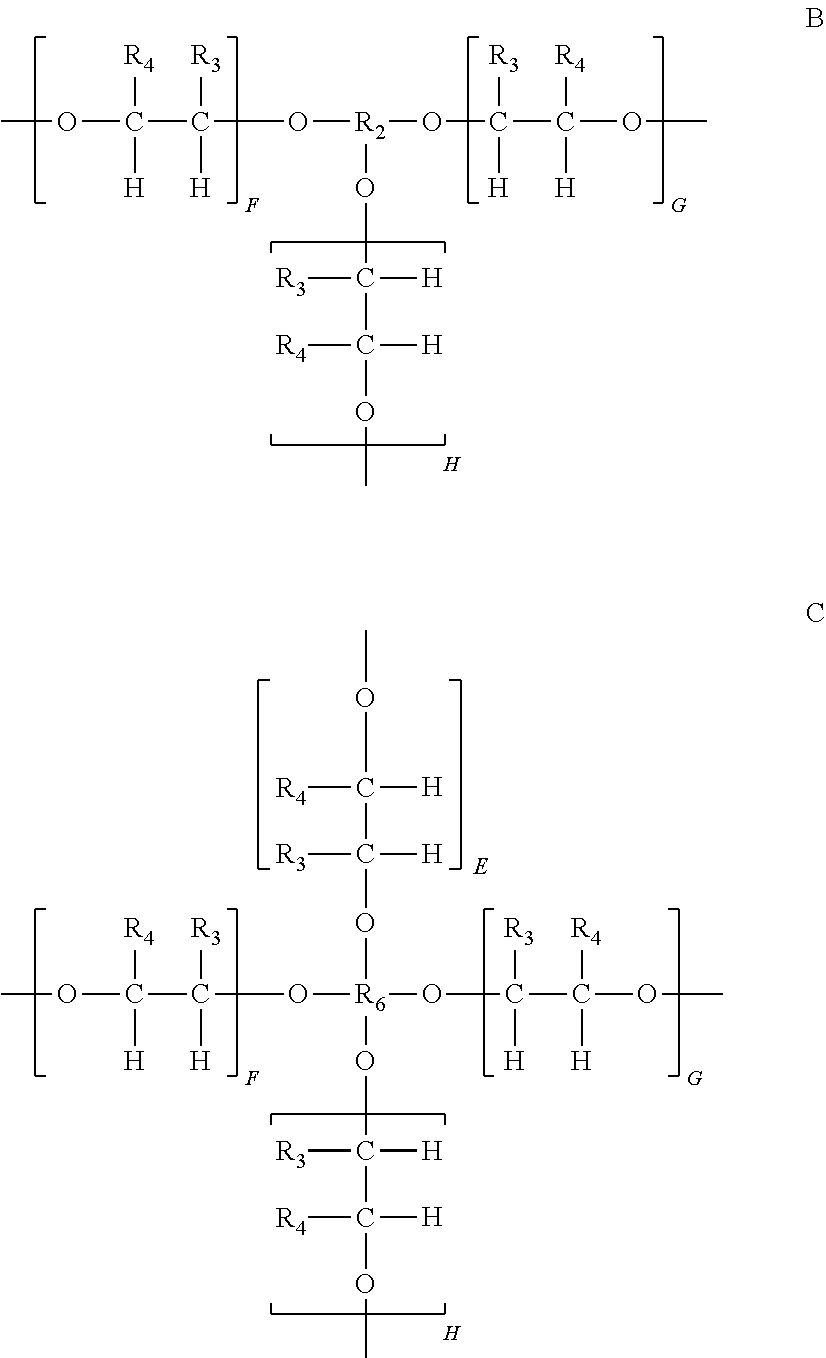Initiator blends and photocurable compositions containing such initiator blends useful for 3D printing
a technology of initiator blends and photocurable compositions, applied in the field of initiator blends, can solve problems such as finished 3d printed articles, and achieve the effects of improving thermal stability, good clarity, and reducing the cost of 3d printing
- Summary
- Abstract
- Description
- Claims
- Application Information
AI Technical Summary
Benefits of technology
Problems solved by technology
Method used
Image
Examples
example 1 (
t-Amyl Type Monoperoxycarbonate Peroxide)
[0143]In this example, the use of a select t-amyl type monoperoxycarbonate class of peroxide is demonstrated, specifically Luperox® TAEC whose chemical name is t-amylperoxy-2-ethylhexyl monoperoxycarbonate. It is used at low levels and produces a 3D printed finished part that results in low residual monomer content and by visual inspection has low color after a post-curing step at 130° C. for one hour in a hot air oven.
[0144]Materials:
[0145]UV-Photoinitiator: Ciba® Irgacure® 819 (Phenylbis(2,4,6-trimethylbenzoyl)phosphine oxide) CAS#162881-26-7 (structure is provided below). It is also known as Photoinitiator 819 or “BAPO” and has a UV Absorption (nm) range of 295-370 nm UV lasers and 390-405 nm UV LED light.
[0146]Sartomer® SR-150 (Ethoxylated Bisphenol a Dimethacrylate)
Resin Formulations in 3D Printer Testing for Example 1
[0147]SR-150 (ethoxylated bisphenol A dimethacrylate, a product of Sartomer, Exton, Pa.) whose structure is provided abov...
example 2 (
t-Amyl Type Dialkyl Peroxide)
[0165]In this example, a 50:50 blend of two Sartomer monomers is used (SR-833 and SR-531)
[0166]Sartomer® SR-833 (tricyclodecane dimethanol diacrylate) has the structure:
[0167]Sartomer® SR-531 (cyclic trimethylolpropane formal acrylate) has the structure:
[0168]A 3D Article Labeled #1 is Printed Using the Following Formulation:[0169]50.00 parts of Sartomer® SR-833 (tricyclodecane dimethanol diacrylate)[0170]50.00 parts of Sartomer® SR-531 (cyclic trimethylolpropane formal acrylate)[0171]1.50 parts of Irgacure® 819 (Phenylbis(2,4,6-trimethylbenzoyl)phosphine oxide)[0172]0.35 parts of Luperox® DTA (96% assay) (di-t-amyl peroxide), a preferred t-amyl type dialkyl peroxide initiator used in the practice of the present invention.
[0173]A 3D Article Labeled #2 is Printed Using the Following Formulation:[0174]50.00 parts of Sartomer® SR-833[0175]50.00 parts of Sartomer® SR-531[0176]1.50 parts of Irgacure® 819[0177]0.28 part of Luperox® DI (98.5%) (di-t-butyl perox...
example 3 (
t-Amyl Type Diperoxyketal Peroxide)
[0184]A high molecular weight diacrylate monomer (Sartomer® SR9003B), whose chemical name is propoxylated neopentylglycol diacrylate, is blended 50:50 on a weight basis with Sartomer® CN9007 (an aliphatic polyether urethane acrylate oligomer)
Diacrylate Monomer; Sartomer® SR9003B Structure
[0185]
[0186]In addition to the UV initiator Irgacure® 819, this example also includes a second UV initiator: Lambson Speedcure® BEM which is a blend of benzophenone+2-methyl benzophenone+4-methyl benzophenone photoinitiators.
[0187]A 3D Article Labeled #1 is Printed Using the Following Formulation:[0188]50.00 parts of Sartomer® SR9003B[0189]50.00 parts of Sartomer CN9007[0190]2.00 parts of Lambson Speedcure® BEM (a benzophenone blend described above)[0191]0.50 parts of Irgacure® 819 (phenylbis(2,4,6-trimethylbenzoyl)phosphine oxide)[0192]0.30 parts of Luperox® 531M80 (80% assay) (1,1-di-t-amylperoxy cyclohexane), a preferred t-amyl type diperoxyketal peroxide initia...
PUM
| Property | Measurement | Unit |
|---|---|---|
| temperature | aaaaa | aaaaa |
| temperature | aaaaa | aaaaa |
| temperature | aaaaa | aaaaa |
Abstract
Description
Claims
Application Information
 Login to View More
Login to View More - R&D
- Intellectual Property
- Life Sciences
- Materials
- Tech Scout
- Unparalleled Data Quality
- Higher Quality Content
- 60% Fewer Hallucinations
Browse by: Latest US Patents, China's latest patents, Technical Efficacy Thesaurus, Application Domain, Technology Topic, Popular Technical Reports.
© 2025 PatSnap. All rights reserved.Legal|Privacy policy|Modern Slavery Act Transparency Statement|Sitemap|About US| Contact US: help@patsnap.com



